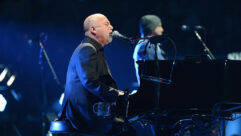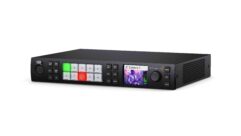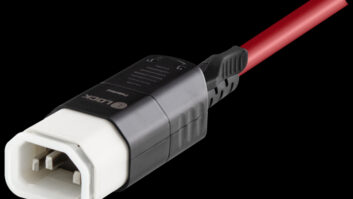On this edition of the SVC Podcast, Contributing Editor Bennett Liles continues his discussion with Mike Cook, Audio Manager for the Carolina Opry at the Calvin Gilmore Theatre in Myrtle Beach. Mike tells us about the recent shows that have been held in the facility and he talks about the DiGiCo mixers used for FOH and monitoring, the Shure wireless mics and the Sennheiser in-ear monitoring used by performers there. He also discusses the venue’s acoustics.
Links of Interest:
· RCF 9006-SA active high power subwoofer
Sennheiser G4 in-ear monitor system
This is the SVC Podcast from Sound & Video Contractor with Mike Cook of the Carolina Opry. We’ve got all the show notes and product links for the podcasts at svconline.com. Go to Podcasts at the top of the page.
The Myrtle Beach, South Carolina area was hit hard by Hurricane Florence and its flooding, but the Calvin Gilmore Theater and the Carolina Opry came through and the shows are bigger than ever. That’s due in part to their new RCF house sound system. Audio Manager Mike Cook is back this week to finish his story on the theater, the shows and how they get it all done. That’s up next on the SVC Podcast.
Mike, good to have you back with us on the SVC Podcast from the Carolina Opry in Myrtle Beach and the Calvin Gilmore Theater, home of that show, another big one called Time Warp, and a whole range of other shows.
Thank you, Bennett for having me back for Part 2 of this. The acts and stuff that we have there, we do have the Carolina Opry show, which is more country-based, a little Broadway and a little Top40, and then we have the Time Warp show, which is 60s, 70s and 80s. And when I say that I’m talking about everybody from the Shirelles and Otis Redding to Journey to Led Zeppelin, and people really love that show because it’s pretty rockin’. The new rig definitely makes the energy in the room come alive, so we’re real happy about that. Plus now, here at the end of October, we’re already rehearsing the Christmas show which opens November 1. So that will be going on all the way through I think the 5 of January this year. And then we have some down time when we normally do repairs and maintenance to the theater. But so far this year we’ve had special acts like America, Kansas, LeAnn Rimes, and all the engineers for them that have come in have loved the system. In fact, Chad for Kansas had never used the RCF rig – any of their products – and he immediately said it was going to go on his tech support list as one of his preferred speaker hangs when they go into venues. They have an option to pull in outside production companies, they’re going to request those HDL-30’s. [Timestamp: 2:13]
You also have DiGiCo mixers in there. Was that part of the original equipment or why did you decide to go with those for front of house and monitoring?
The original equipment actually went through several consoles. There was a Midas – there was Yamaha 4K before the Midas and then we went to Midas Legend. We have about 40 people on stage at any given time; people running on and off. It was just a natural transference from the analog desk to a digital desk just to make the show flow more and an act can be more consistent. And we looked at a lot of desks and there are a lot of digital consoles out there, but DiGiCo really fit the bill and personally I think it’s one of the best, if not the best-sounding console out there. And that’s the reason we went with that for front of house. We have an SD10 at front of house and we then we have an SD11 we use for supplemental monitor mixing. But most of the monitors and stuff I do are actually run from front of house to my mix to the band and then they have the option of taking a stereo mix that they prefer from the little SD11 that we have backstage. [Timestamp: 3:18]
Yeah I’m sure that you run into a lot of technical situations with all of the different types of acts and performers. I noticed from the videos out of there that you’re pretty heavy on wireless mics so what kind of wireless mic system do you use?
Well, we’ve got about 40-42 frequencies rolling around on each show; that’s belt packs and handhelds. But the bulk of our wireless systems are the UHR Shure’s. We have a couple of ULXD digital systems they have. And as far as the microphone heads, we have kind of a mixed bag I guess would be the best word to use. I kind of picked the SM86 for some of the girls’ vocals because it’s a little smoother Shure microphone, the standard SM58; I do have some Beta 87’s on some of the guys. And I pretty much picked the microphone heads for that particular voice. I know that’s a little out of character because most of the time you’d rather have all matched heads so you can start out with a basic EQ, but since we do the same shows day in and day out, the same people use their own microphone. I just thought it was easier EQ-wise and tailor it to their voices if I was able to use the element that fit their voice better. [Timestamp: 4:31]
You’ve got so many different people and so much stuff to keep working, do you ever run into any problems with RF coordination? Is there other stuff going on in that immediate area?
Yes. We have venues around us that have some RF, but luckily the building is well-grounded. I don’t have much outside interference. The biggest thing now if we need to add stuff is finding something that will work inside the building because of 40-42 frequencies from wireless transmission. And then we have probably about 16 in-ears the guys on stage use and most of those are wireless. There’s only one that’s wired out of the whole building, so that does present a challenge. But we went with the Sennheiser products, the G3’s and the G4 in-ears, and they work great for us. So far so good as far as finding frequencies that are open. It’s very rare we have a drop-out in the show. It does happen occasionally, but I’d say probably 99.9 percent of the time we don’t have issues with that during any of our shows. [Timestamp: 5:34]
And the acoustics in there must be interesting with such a classic-looking place with winding staircases going up to the balcony, you have hanging chandeliers. Do you have any sort of acoustic panels or other treatment in the house?
Yes. In fact, the whole room is treated. We have acoustic panels down each wall set, on the balcony rail, and there’s what I call a deadening curtain against the back wall underneath the balcony. The balcony luckily does not jut out but about probably eight feet into the main space, the main floor, so I don’t get much collection from underneath there and it’s real dead. The room is pretty much designed for amplified music, which is really good for our situation. It almost gets to the point of being studio quality. I can get that, if I’m on my A game that is. It all depends on how I’m mixing that night. But the reflection in the room is pretty much down to nothing, which is really helpful as far as clarity and intelligence in the room. [Timestamp: 6:30]
Of course, all that stuff runs on power so how has your power situation been since the storm and the flooding? Have they pretty much kept the power consistent?
Yes. In fact, believe it or not, I commented on that to Paul, the L.D. at the Opry. For some odd reason years ago when the system was installed – the original system – pretty much 115-116 volts were what we were getting on all the locations. And I kept saying I’d really like to have the transformers outside the building or the transformers feeding the building, I’d like to at least turn them up to 120 or 122. And it seems like after this storm when they put everything back online they must have put in new transformers because I have a consistent 120 in the house, which actually raises my threshold for the rig and the rig is a lot happier with that. The other side of that coin, though, is I’ve noticed that all the RCF products, all the HDL series anyway that I’ve used, are very power-stingy. They don’t require much to get a lot out of them. The amperage they draw is next to nothing. I know what the ratings in the manual show and we put amp meters in, and even at the power we run them at, if we’re running them at 60-70 percent, they’re still drawing about a third of what they say the rating is for that particular power in their manuals and I’m real happy about that. Their product has just been incredible all the way around the board, and especially the support that RCF has given us. [Timestamp: 7:59]

Well, nobody could have asked for it to be tested more severely than what you’ve had and everything came through it. So what kind of upgrades would you like to do from here? Anything planned for sound or lighting?
I think in the sound system world we’re in pretty good shape. Every now and then, of course, we have some microphones to replace and things. After the Christmas show is done and we have some downtime we’re talking about actually rewiring the stage – some new drops and snakes and stuff – because we do have a lot of CAT5 that goes to my mixes and things underneath the stage, and that tends to wear out. Even though we’re using stranded cable, our stage itself actually moves about 20 feet from the back wall forward, so there is some torque on the cables and stuff. We’d like to replace that before we get into cable issues of cables shorting out or being torn, and especially the electrical and stuff. But as far as lighting is concerned, we normally add probably 6-10 movers a year. We’ve pretty much gone to all LED. We do have some conventional lights still, but very few. And we’re probably going to upgrade the front of house console for the new grandMA desk that’s come out. We’re actually waiting, just like anything. In the digital world we like for the console to be out a couple, three months or six to eight months to get the digital bugs out of them and then we’re probably going to move forward with that. Video-wise, we use GoPros. We have several of those around the stage. We also use Sonys in the booth for the video world and we have a video screen and two large projection screens, so we run an IMAG during the show. And it’s definitely made a total difference in the way the show – with the reaction of the audience because they can see more. There’s a lot more energy involved by having the IMAG. [Timestamp: 9:42]
Oh yeah, I can imagine. That really adds a lot to it. And you have your own company. Tell us what you have there and where you plan to go with that.
We’ve made some changes in the business. The company was MC Sound, Light and Video. And we’ve actually divided it now. My side of the business is MC Sound Consultants and my business partner has a company called MC Lighting and Sound. And he’s going after more of the wedding market and outdoor production stuff and doing really well with it. The wedding market in this particular area is incredible, especially with Charleston I think being #1 in the wedding destination in the nation here. Of course the brides and grooms and all those people, they want tents and everything – lighting and the whole nine yards. Carleton Whilden has done a great job with that. Here pretty soon we’ll split the web site up so that we have MC Sound Consultants web site and MC Lighting and Sound so you can go to those individual sites. And I’m focusing more on doing system design and installation, sticking basically with sound. I do a little bit of lighting, but basically I’m a sound guy. I’ve been doing this for 42 years and I think it’s probably best I stay in that realm because you don’t want to put me behind a lighting console, I can tell you that right now. [Laughs] That’s not my forte or expertise. But I do have several church installs I’m working on right now, and quotes, and working on another theater, which at this particular point in time I’m not at liberty to discuss. And looking like I’m probably going to use all RCF products for all those just because stability and I just like their products. It fits in pretty much any installation I’ve done and they have boxes that fit pretty much any situation I run into. [Timestamp: 11:26]
Good to go with what you know where you know what to expect. It’s been great hearing about the Carolina Opry. There are loads of videos on YouTube. You can see what’s going on there, a fantastic show. Talking with Mike Cook, Audio Manager at the Calvin Gilmore Theater, a great-looking place in Myrtle Beach. Everything is back up and running there so get on back to the area and take it all in. Great to have you with us, Mike.
Thank you, Bennett. Thanks for your time. Have a great one.
The next time you visit the Myrtle Beach area, take in the Carolina Opry at the Calvin Gilmore Theatre. With their RCF upgrade the sound has never been better and they’ve got shows for the whole family. We’ve got more AV installation features so get with us for that on that for the next SVC Podcast.










